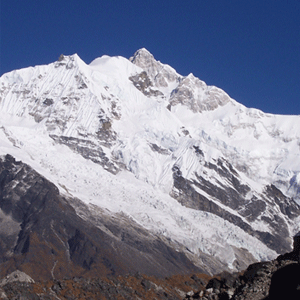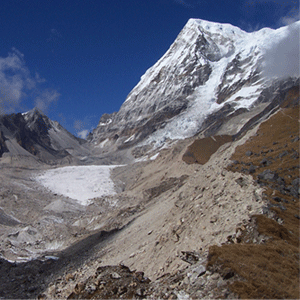|
Physical Features of Sikkim |
|
Physical
Features of Sikkim |
|
Sikkim has a very
rugged topography due to which there are very less flat lands.
The rivers, mountains are the main physical features that define
the boundaries of the state of Sikkim with its neighbours.
Besides the rivers and mountains, the glaciers, passes, lakes,
hot springs and waterfalls are also found in this region. |
|
|
|
|
Mountains
in Sikkim |
|
Sikkim is a land of
the high mountains that seem to touch the heavens and define the
paradise of nature. These mountains form a part of the
Himalayas, the highest mountain range. The Mount Kanchenjunga,
the third highest mountain in the world is situated in the Sikkim. This mountain range can be seen from almost any part of
Sikkim and border the Sikkim from the northern, eastern and
western side. The two main mountain ranges in Sikkim
are the Singilela range on the Western border and the undulating
Chola range on the Eastern border. The boundary between Sikkim
and Bhutan is defined by the Pangolia Range located in the south
eastern part of the state. Other peaks that stand at altitudes of above
20,000 feet are Siniolchu, Pandim, Kabru, Rathong, Kokthang,
Talung, Kanglakhang, Simvo and Jonsang. The other imposing
mountains that are slightly less than 20,000 feet are
Masthonangye, Yabukjakchen, Narsing and Lamaongden. Most
of the peaks of Sikkim have remained unscaled as the Sikkimese
consider them sacred and feel that they will lose their sanctity
if climbed. |
 |
|
|
|
|
Mountain Passes
in Sikkim |
|
The mountain ranges are interspersed with various passes which
can be used to cross from one side to another. The two most
important passes are the Nathu la and Jelep la pass located on
the eastern Chola range at an altitude of about 14,500
feet. The Nathu La pass is also known due to the war between
China and India. Nathu la and Jelep la passes also formed a part
of the trade route between India and Tibet till 1962. The Bhutan
la pass is located at an altitude of about 13,000 feet. The
first two pass leads to the Chumbi valley in Tibet and the third
pass leads to Bhutan. Another important pass on this range that
also leads to the Chumbi valley is the Chola pass which was used
by the Chogyals to go to Tibet from Tumlong. Chiwabhangjang is
the another important pass located on the west between the
Sikkim and Nepal border. From this pass the Nepalese used to
attack Sikkim during the last century. The other pass on the
west is Kang la. |
|
|
|
|
Glaciers in Sikkim |
|
 |
A glacier is a slow
moving river of ice. The glacier flows from high mountain peaks
through rocky valleys and carries unmelted snow, rocks and debris
that has compacted over many years into a solid, creeping ice
stream. According to some people, about thousand years ago the
whole of North Sikkim was covered with glaciers. Lachung is
situated at the base of an ancient moraine. The most important
glaciers in Sikkim are the Zemu Glacier, Rathong Glacier and the
Lonak Glacier in North Sikkim. The Zemu glacier is the largest and
the most famous glacier of the eastern Himalayas. This glacier is
about 26 km in length and is situated in a large U-shaped valley
at the base of the Kanchenjunga mountain in the northwestern
Sikkim. The Teesta River rises from the snout of this glacier.
Various icefalls and waterfalls have been formed at the junction
of the tributary glaciers with the Zemu glacier.
|
|
|
|
|
Lakes in Sikkim |
|
Sikkim has a
rugged terrain but though still some lakes are also found in
this area. There are some lakes which are not very large in
size. These lakes are both spring fed as well as river fed.
They also form the source of many rivers. The Changu Lake is
situated on the highway between Gangtok and Nathu-la, about 34
kms from Gangtok. The Bidang cho and the Menmoi cho are the
two other lakes which are also found in Sikkim. Khechopari
lake is another well known lake that lies on a bifurcation of
the route between Gyalshing and Yoksum. Laxmipokari, Lampokari,
Majurpokari, Ram and Laxman lake, Cholamu and Green Lake are
some of the beautiful lakes which are also found in Sikkim.
Gurudogmar lake is the largest and probably the highest lake
in Sikkim. |
|
|
|
|
Rivers in Sikkim |
|
The rivers which are found in Sikkim are fed by the snow melting
on the mountains and also by the rains that accumulates in the
catchment areas during the monsoons. The rivers of Sikkim are
perennial and do not dry out even during the winters. Some of
these rivers also have a potential of generating thousands of
megawatts of electricity. The two main big hydroelectric
projects are built on the Rangit and the Teesta rivers. The
valleys of the rivers towards the North of Sikkim are wide and
concave shaped due to the presence of glaciers millions of years
ago, but on moving southwards these valleys transform into deep
V-shaped gorges. The rivers are very narrow, steep and full of
rocks due to which they are not navigable. During the monsoons
these rivers become swollen, swift, muddy and dangerous.
The main river found in Sikkim is the Teesta river. When the
Teesta river approaches the border between Sikkim and West
Bengal it becomes wide and clear of rocks and it is possible to
raft across it. The Teesta finally joins the Bramaputra in
Bangladesh. The Teesta river flows almost right across the
Sikkim. The Teesta river orginates from the Cholamu lake where
it is hardly a stream. Its major tributary is the Rangeet which
originates from the Rathong Glacier and meets it at the border
between Sikkim and West Bengal. The Teesta river flows in the
North - South direction while its tributaries flows in the South
West or South East directions. The river Ramam, a tributary of
Rangeet river and Rangpo chu, the tributary of Teesta river
defines the Southern border between Sikkim and West Bengal. The
other smaller tributaries of the Teesta river are Zemu chu,
Lachung chu, Talung chu, Bakcha chu. |
|
|
|
|
Hot Springs in
Sikkim |
|
Sikkim has various hot
springs which are known for their medicinal and therapeutic value.
The most important hot springs are located at Phurchachu (Reshi),
Yumthang, Ralang and Momay Samdong. All these hotsprings have high
sulphur content and are located near the river banks. The average
temperature of the water in these hot springs is 50 degrees
Celcius. These springs are considered holy as one of the four holy
caves is located here. This holy cave is called the Kadosangphu or
'cave of the occult fairies' and lies on the south of the four
cardinal points. The Yumthang Hot Springs is the famous hot spring
located at an altitude of 12000 feet in the North Sikkim. To reach
at this place one has to cross a few hundred metres off the road
and cross a bridge. At this place a small hut is situated where
the hot water is collected in a pool, where one can take a dip. |
|
|
|
|
Waterfalls in Sikkim |
|
The verdant green landscape of Sikkim is broken by the
waterfalls that leap out of the hillsides in the valley. Most of
these waterfalls are perennial, fed by the spring water and
snows which melt on the mountains. These waterfalls can be found
almost all over the Sikkim but some of the waterfalls are found
in the North Sikkim specially on the road between Mangan and
Lachung as well as in the Dzongu area. |
|
|
|
|
|
|
|
|
Back |
|
|

